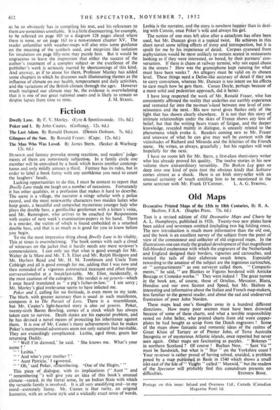Old Maps
Tins is a revised edition of Old Decorative Maps and Charts by A. L. Humphreys, published in 1926. Twenty-two new plates have been added and seventeen omitted (including two big folding ones). The new introduction is much more informative than the old one, and the book is an excellent survey of the subject from the point of view of the connoisseur and collector of old engraved maps. In the illustrations one can study the gradual development of that magnificent full-blooded exuberance with which the engravers of the Netherlands and England designed their borders, vignettes and cartouches, and twisted the tails of their elaborate swash letters. Especially rewarding to the amateur of the subject are the ingenious cartouches, or " compartiments" as one surveyor called them. " Comparti- ments," he said, " are Blankes or Figures bordered with Anticke Boscage or Crotesko worke." They were indeed ! The great names in the book are, of course, those of Ortelius, Mercator, Blaeu, Hondius and our own Saxton and Speed, but Mr. Skelton is interesting and informative about the Italian and French map-makers, less familiar to the general reader, and about the sad and undeserved frustration of poor John Norden.
These maps lead one's thoughts away in a hundred different directions. How many poor seamen must have been drowned because of some of these charts, and what a terrible responsibility rested on John Seller, who printed charts from old worn copper- plates he had bought as scrap from the Dutch engravers ! Some of the maps show fantastic and romantic ideas of the realms of Great Khan of Tartary or of Prester John, of Terra Australis Incognita or of mysterious Atlantic islands, once reported but never seen again. Other maps are fascinating as puzzles. " Bokenes " in northern Scotland ? Of course ! Buchan Ness. " Sant Vic " must be Sandwich, but what is " Star " on the Yorkshire coast ? Your reviewer is rather proud of having solved, unaided, a problem posed by a map published in Basle in 1540 which shows a small islet east of the Isle of "V,t4Sht " called " Manwid," but the readers of the Spectator will pfobably find this conundrum presents no


































 Previous page
Previous page